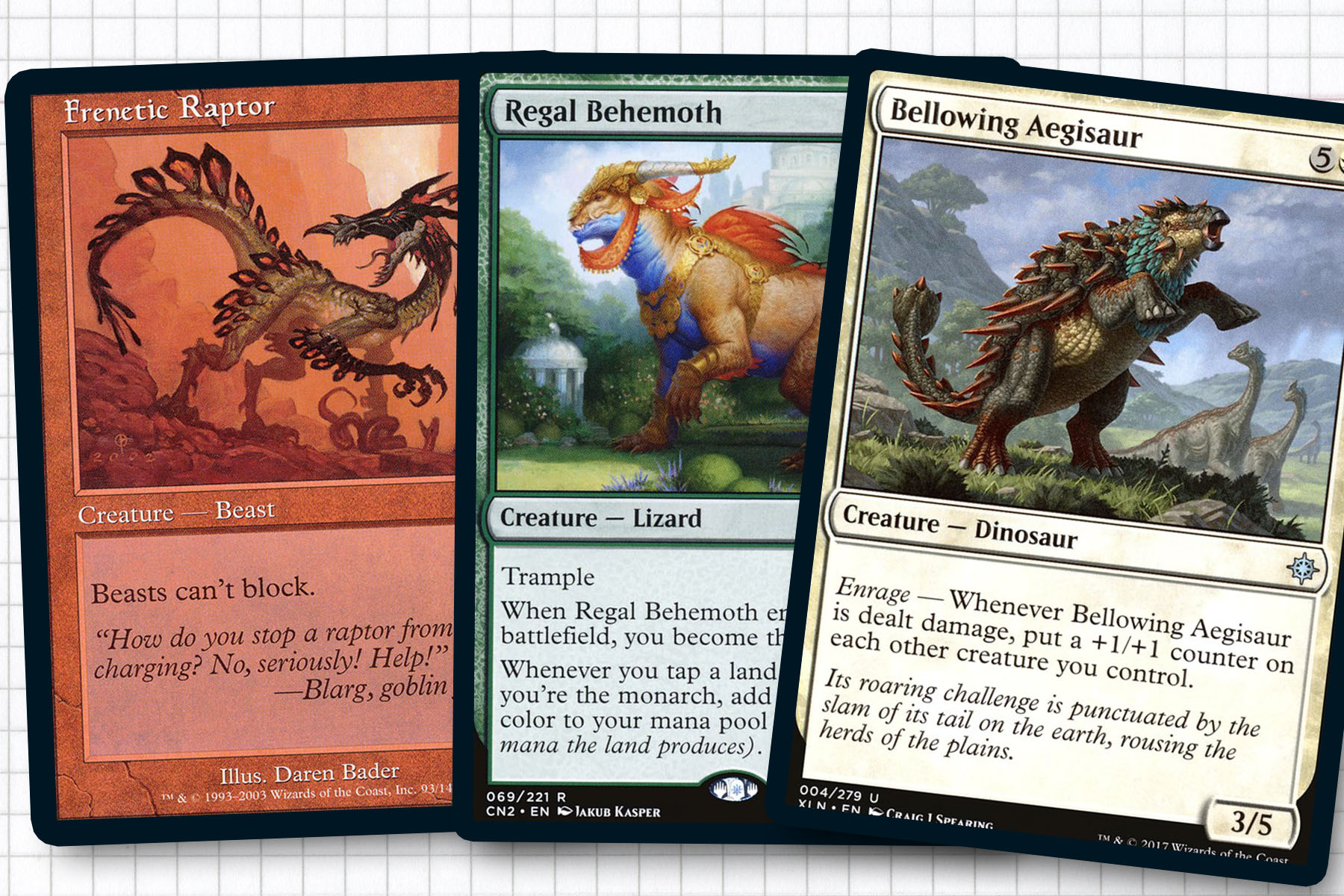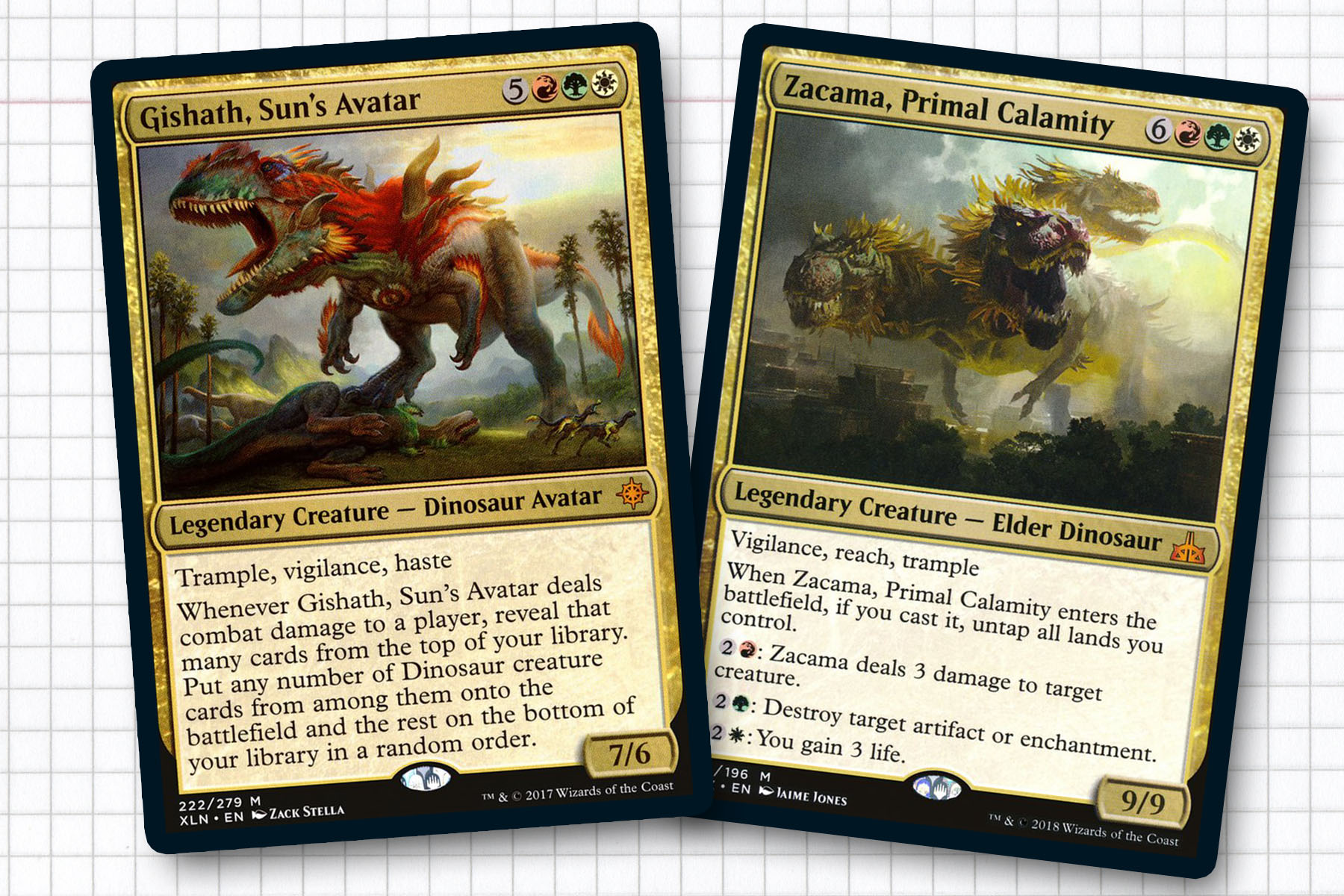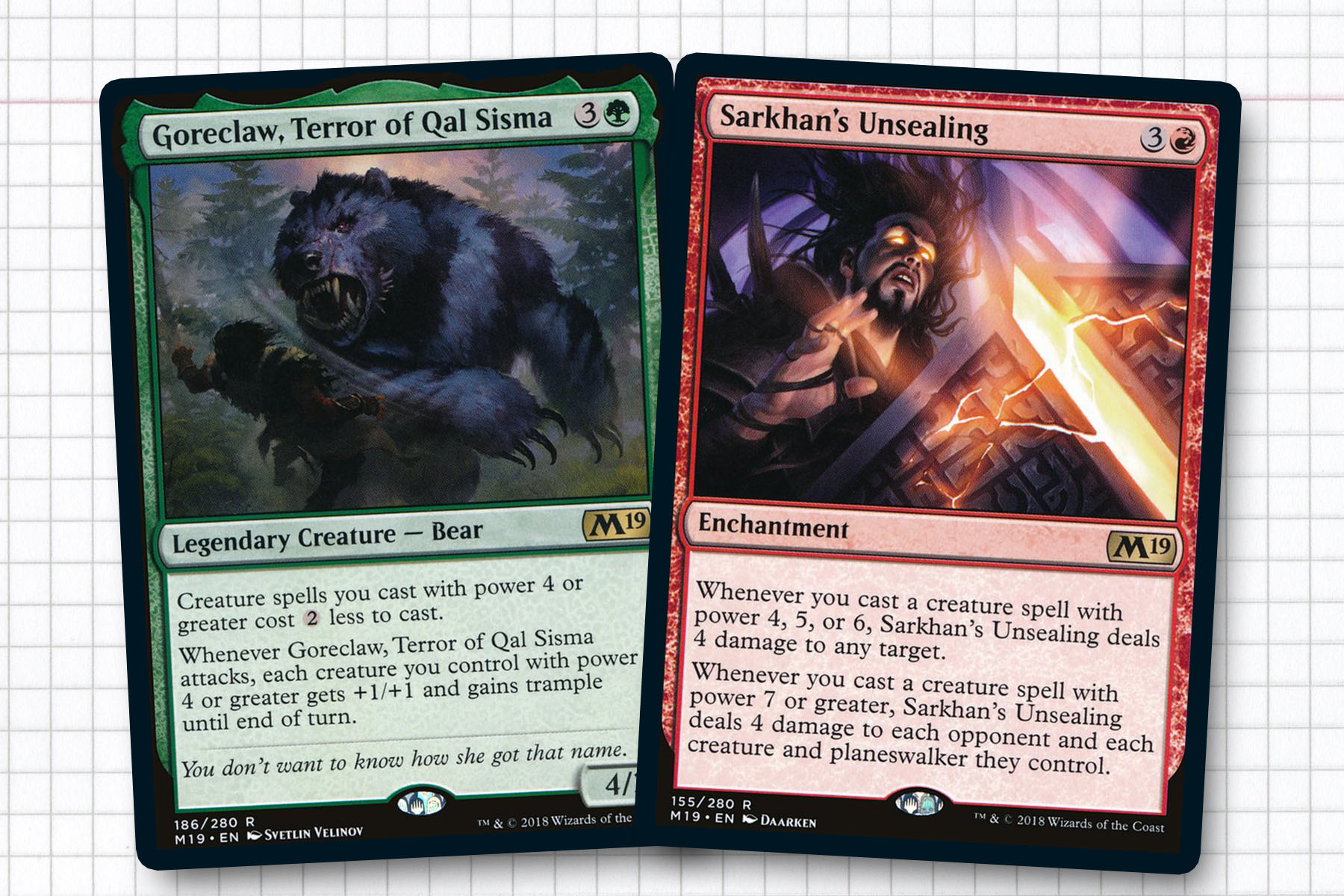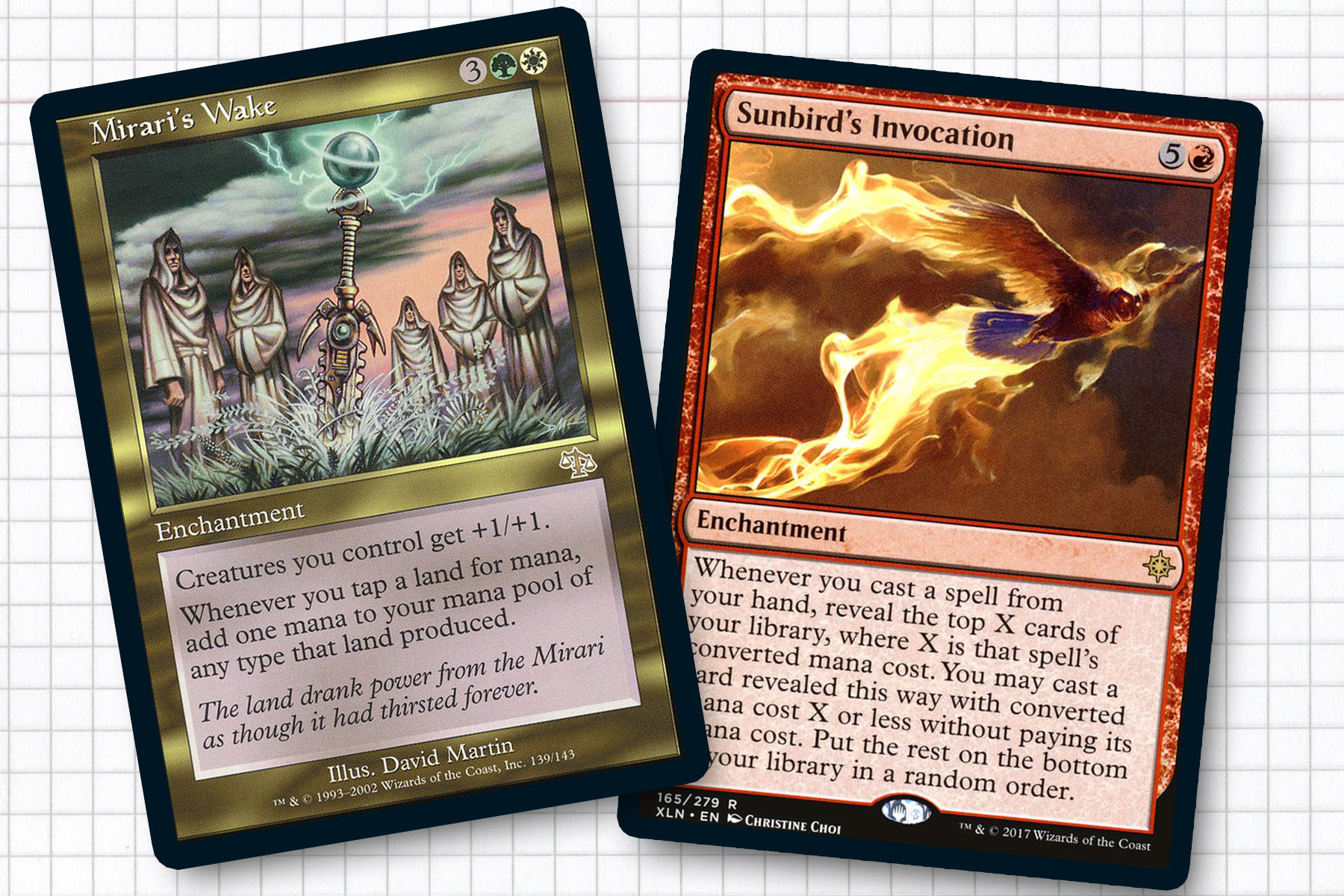There are a lot of choices in Commander, which is why I happen to love it far more than any other format in Magic. With the deck size and deck-building requirements, it is undoubtedly a format of self expression for a lot of people, myself included. Yet I also believe that the generosity of the community and their willingness to borrow decks to other players is a big factor as well. Not only are you able to flaunt your deck, but skilled deck builders can assemble something that can be understood by a pilot who has never touched the deck. This week, we will be looking at one of the decks I’ve built with borrowing in mind, Gishath, Sun’s Avatar.
As an aggressive deck first and foremost, I consciously wanted something that could be easily piloted by another player. By keeping the win condition simple, sprinkling in a few surprises throughout the dinosaur tribal shell, and taking cues from other decks I’ve built; I assembled something that generally results in a positive experience whether I’m playing with or against it. Let’s take a look.
General: Gishath, Sun’s Avatar
Creatures: Apex Altisaur, Bellowing Aegisaur, Flamekin Herald, Garruk’s Packleader, Gemrazer, Geode Golem, Ghalta, Primal Hunger, Goreclaw, Terror of Qal Sisma, Hellkite Courser, Mirror Entity, Pale Recluse, Priest of the Wakening Sun, Quartzwood Crasher, Ranging Raptors, Regal Behemoth, Regisaur Alpha, Ripjaw Raptor, Shifting Ceratops, Temple Altisaur, Thrashing Brontodon, Valley Rannet, Wakening Sun’s Avatar, Wayward Swordtooth, Yidaro, Wandering Monster, Zacama, Primal Calamity, Zetalpa, Primal Dawn
Enchantments: Bower Passage, Canopy Cover, Elemental Bond, Garruk’s Uprising, Guardian Project, Lurking Predators, Mana Flare, Mana Reflection, Mirari’s Wake, Rhythm of the Wild, Sarkhan’s Unsealing, Sunbird’s Invocation
Artifacts: Arcane Signet, Fellwar Stone, Herald’s Horn, Sword of the Animist, Urza’s Incubator, Wayfarer’s Bauble
Planeswalkers: Huatli, Radiant Champion, Huatli, Warrior Poet
Instants: Akroma’s Will, Boros Charm, Disenchant, Eladamri’s Call, Kindred Summons, Return to Nature, Sylvan Reclamation, Unbreakable Formation
Sorceries: Anger of the Gods, Broken Bond, Chain Reaction, Kindred Charge, Road of Return, Treacherous Terrain
Lands: 11 Forest, 6 Mountain, 4 Plains, Ash Barrens, Blossoming Sands, Clifftop Retreat, Command Beacon, Ghost Quarter, Jungle Shrine, Path of Ancestry, Rootbound Crag, Stone Quarry, Sunpetal Grove, Tectonic Edge, Temple of Abandon, Temple of Plenty, Temple of Triumph, Thriving Bluff, Thriving Grove, Thriving Heath, Timber Gorge

A History of Dinosaurs
Dinosaurs have always felt like a low hanging fruit for Magic: a creature type that was immediately iconic, while also being infinitely mutable with the right sensibilities. I remember when I started playing Magic, I was surprised that dinosaurs were not supported as a tribe. Before really understanding what the iconic creature types for each color were, dinosaurs felt like a fine tribe when downgrading from dragons, especially since Frenetic Raptor and Ridgetop Raptor both came out within my first year of playing.
When dinosaurs finally made their debut into Magic, I genuinely thought that they would come in during Ixalan and taper off as the block disappeared from Standard. While that is mostly true, the tribe received sustained support nearly every set, making the right time to move forward with a dedicated list. While the pool of cards is not perfect, now has proven to be a time where the amount of available dinosaurs has created room for individuality.

Why not Zacama?
Hype can be a very deceptive factor in a Commander metagame. If you would have asked me in early 2018 what the typical general in a dinosaur deck would be, I would have assumed that Zacama, Primal Calamity was the obvious choice. Yet there’s a reason why Zacama didn’t sustain the amount of hype that it got when it was printed in January of 2018. Zacama is a great combo general, but a poor tribal choice.
Gishath, Sun’s Avatar, on the other hand, was the general we needed from the beginning. For the eight mana investment, you get a general that makes an impact immediately and circumvents the higher than average costs of their tribe. Additionally, the deck tends to be easy to understand and doesn’t require a lot of explanation if you want to lend to a friend for the night if they happen to be without a deck. Zacama still has a very serviceable place in the 99, as they work great as a deadly attacker who also serves some utility.
Overall, the deck thrives on building in the early turns of the game with ramp and using the inevitable casting of Gishath to quickly turn the tide by flooding the board with creatures off the top of our deck. This has generally worked out great. On the modest end, you might only find two dinosaurs; but the times I’ve hit four, I either took down the threat at the table or claimed that title for myself.

Lessons from the Eldrazi
One of the lessons that I learned as I was working on my Shattergang Brothers deck was that the core of the Eldrazi tribe is not necessarily these huge titans they are most known for. A lot of the games played by that deck came down to interactions that happened with creatures that had very small bodies but did unusual things, which was the flavor I was looking for. And I found that when I started to look at dinosaurs and figure out where the right feel for the deck was for myself, I realized that I wasn’t playing with huge creatures. I was playing with things that fell into the range of four to six power or toughness.
This was antithetical to what I thought I was going to be dealing with when I started out. I thought that looking for ways to interact with big creatures in the ballpark of Dragon Fangs, Fierce Empath, or Krosan Drover. But I quickly realized that only about 10% of my deck played favorably with those cards. Instead it was valuable to look at permanents like Elemental Bond or Sarkhan’s Unsealing to generate get the amount of triggers that made a difference in games. Suddenly, Goreclaw, Terror of Qal Sisma and Thrashing Brontodon were replacing themselves or acting as removal by simply coming into play.
Another card I expected to be strong but underperforms in this deck is Mirri’s Guile. I assumed it would help to raise my success rate with Gishath’s ability. I quickly discovered that all it was really doing was helping my draw step, ensuring that I would be drawing lands or spells and not dinosaurs that I didn’t need to spend mana on. And while that is likely fine for other Gishath decks, it felt like a step up for an effect that didn’t impact the games it was in.

Let the People Stomp
Through all the small changes I’ve applied to this deck over the last few years, the results have been substantially gratifying. The deck has a very obvious win condition through combat, which makes the deck one of my few safe options I have when loaning it out. Like any deck, there is enough going on it can’t be picked up with cold without some tips: my first piece of advice is to look for green mana and at least one form of ramp in your opening hand. After that, don’t worry; you’ll get the dinosaurs out eventually. When the deck gets into the fourth or fifth turn, the pilot usually expresses some form of glee as they start planning out their big turn.
Sunbird’s Invocation continues to be one of my pet cards and it does a lot of work here. The best twist of fate for this deck being the time I cast Mana Reflection and found Mirari’s Wake in my top six cards. But smaller interactions like casting Zetalpa, Primal Dawn and finding Bower Passage or Rhythm of the Wild have also proven game-altering. This is all to say, this deck may not have a pristine win-loss record, but it generates a lot of stories. Frankly, that’s exactly what I wanted.
Commander is a phenomenal format for anyone who wants an outlet for self expression and this deck is one of my prouder creations in the last few years. Of the tribes coming to us in Ixalan, dinosaurs have proven to be my favorite, mostly for their lack of subtlety. What started out as a Gishath deck, transitioned to Zacama, before ultimately ending up right back where I started. Sometimes, you get it right on first try.
Ryan Sainio is a Graphic Designer who writes about EDH and the EDH community. He has been playing Magic: The Gathering since 7th Edition in 2002 and values flavorful and fun gameplay over competitively optimized decks.

